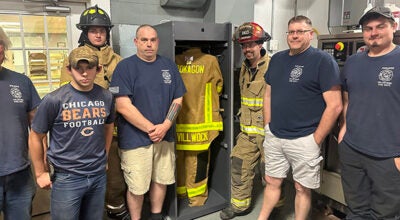Molding Marines: A day in the life
Published 9:12 am Thursday, April 10, 2014

A senior drill instructor leads a guided discussion with recruits Tuesday afternoon. (Leader photo/CRAIG HAUPERT)
The educators’ indoctrination into the life of a U.S. Marine Corps recruit began with a simple order from a loud and angry drill instructor — “Get off my bus.”
Most of the approximately 40 educators, like Niles’ Josie DeJong, knew it was coming. Even so, it was still a jarring moment as she hurried off the bus to take her place on the yellow footsteps that mark the beginning of a recruit’s journey.
“When it actually happened I thought, ‘OK, this is real now. This is happening,’” she said Tuesday, the first full day of the Marines Educators Workshop in San Diego, Calif. “It was a bit of a shock at first. It’s definitely memorable.”
The group was “welcomed” by a single drill instructor standing on a platform well above the wide-eyed educators. Using his loudest possible voice, the drill instructor barked at them about how they were expected to act during a recruit’s 12 weeks of training — everything from how to stand to how to respond to how quickly they are expected to move.
“The yelling and everything was what I expected, but it wasn’t as bad as I had thought it would be,” DeJong said. “It is probably a little worse for the actual recruits.”
Educators were then shuffled into another room where they were lined up in front of rows of red tables. Drill instructors then told them to place their belongings on the table and warned about being caught with unapproved items, like tobacco or electronics.
From there, they were moved quickly to another room where they lined up in front of several white telephones where recruits would make their final scripted telephone call home.
The mock “yellow footprints” exercise wrapped up right before educators would have had to make the phone call.
A short question and answer session followed, where drill instructors explained the reason behind introducing recruits in this way. A recruit’s sense of individuality is removed and broken down so they can be rebuilt as a team.
“It’s that initial culture shock of being in a new place and a new setting where they don’t have control over what goes on,” said Sgt. Quinn Steege, one of the drill instructors. “It is teaching them skills that might help them survive in a combat situation.”
New recruits are introduced to the yellow steps every week — about 300 in the “slow” winter months and about 500 in the summer months, Steege said. Nearly 17,000 new Marines were made in 2013 at the Marine Corps Recruit Depot in San Diego.
“It’s actually a very small majority that don’t graduate and that’s typically because of something they didn’t disclose to their recruiter, or just an injury that would take them too long to keep them to heal,” Steege said.
Educators were introduced to recruits for the first time during lunch Tuesday at a Marines mess hall.
One of the recruits, 22-year-old William Stark, of Lansing, was about to enter the second phase of training, which occurs around the fourth week. At that point, recruits begin learning to shoot and about combat. It’s also the time where they transition away from the “breaking down” phase.
“Things are starting to — I’m not going to say they are getting easier — but I’m in a groove now. I know what’s going to happen each day instead of waking up and not knowing,” he said. “I have full confidence that I’m going to make it.”
Stark was enthusiastic as he told educators that he would marry his fiance the day after he is scheduled to graduate from Marines training. He said it would be two life-changing moments back-to-back.
“It’s exciting,” he said.
Educators spent the rest of the day learning about the recruitment process, including seeing — and in some cases participating in — physical fitness tests and drills demonstrated by Marines leading the tour. One test requires recruits to lift a 35-pound ammo canister over their heads as many times as possible in two minutes.
There was also a martial arts demonstration, a bayonet training course and swimming demonstration, among others.
“Obviously they have to do things differently for us, but I do feel like we got a pretty good feel for what a new recruit would be experiencing,” DeJong said. “It was nice that there was hands on. Those are pretty physical activities.”






